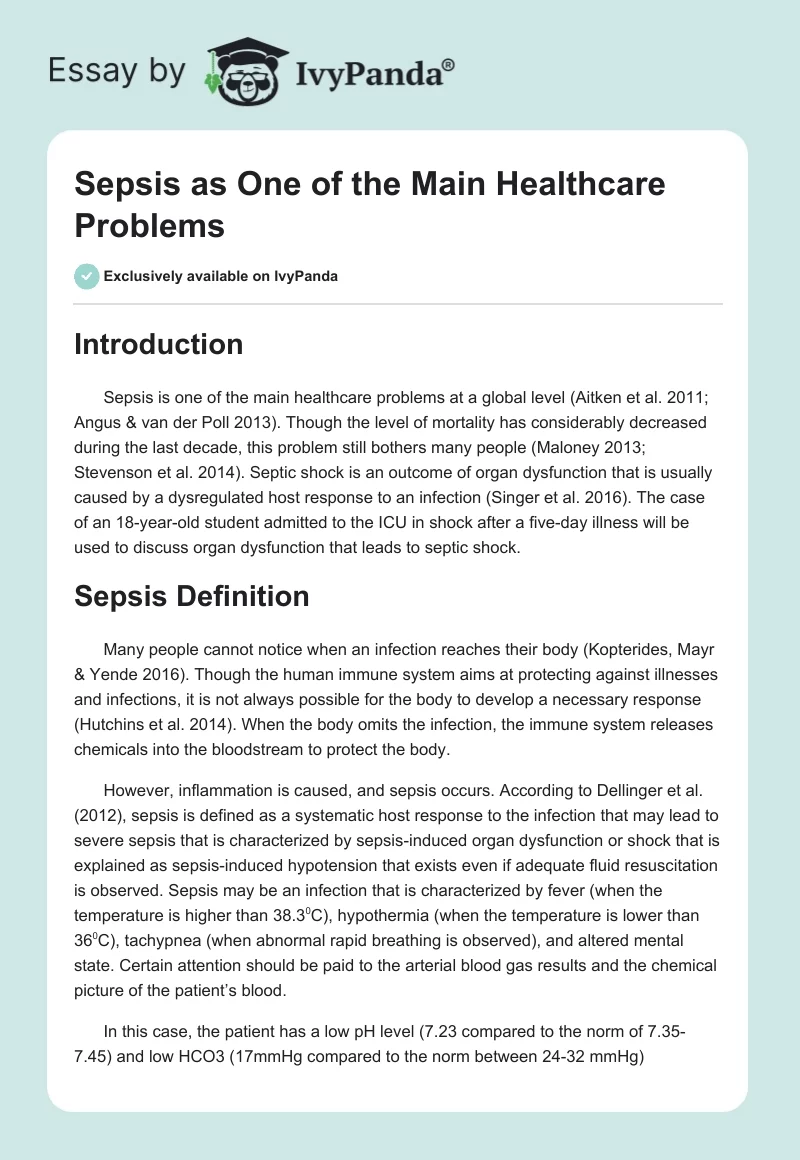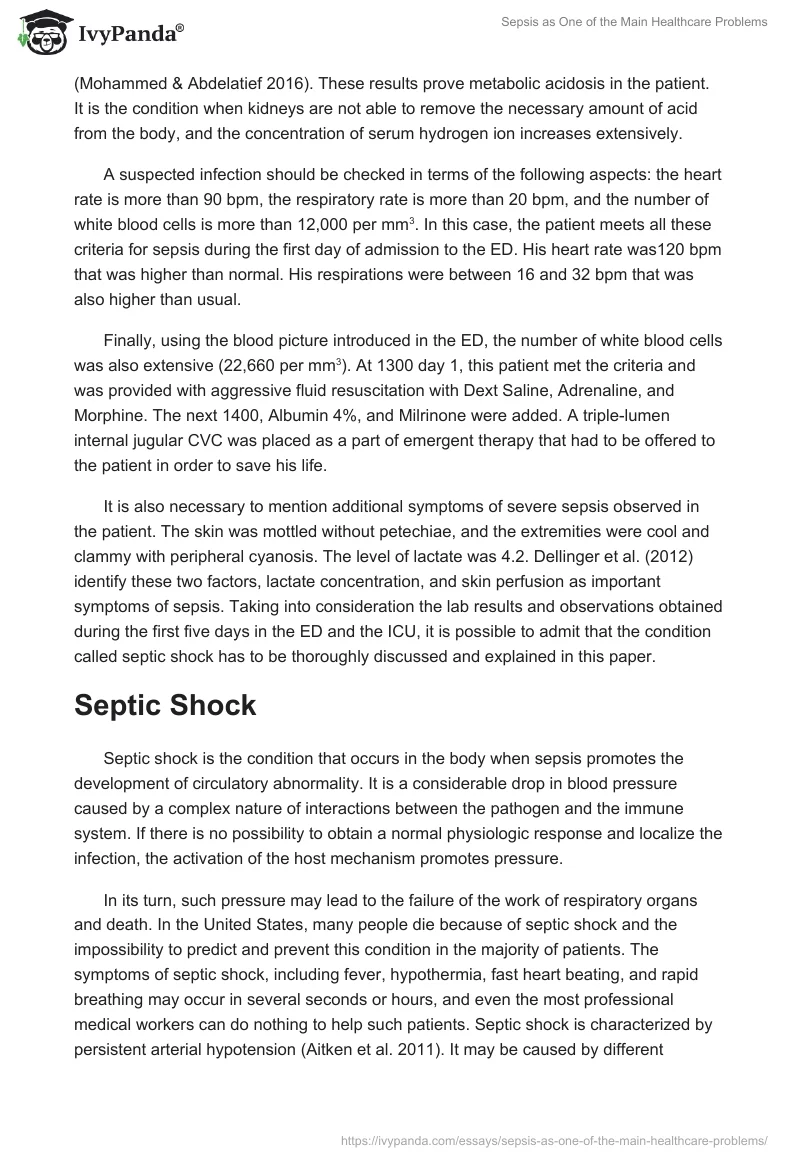Introduction
Sepsis is one of the main healthcare problems at a global level (Aitken et al. 2011; Angus & van der Poll 2013). Though the level of mortality has considerably decreased during the last decade, this problem still bothers many people (Maloney 2013; Stevenson et al. 2014). Septic shock is an outcome of organ dysfunction that is usually caused by a dysregulated host response to an infection (Singer et al. 2016). The case of an 18-year-old student admitted to the ICU in shock after a five-day illness will be used to discuss organ dysfunction that leads to septic shock.
Sepsis Definition
Many people cannot notice when an infection reaches their body (Kopterides, Mayr & Yende 2016). Though the human immune system aims at protecting against illnesses and infections, it is not always possible for the body to develop a necessary response (Hutchins et al. 2014). When the body omits the infection, the immune system releases chemicals into the bloodstream to protect the body.
However, inflammation is caused, and sepsis occurs. According to Dellinger et al. (2012), sepsis is defined as a systematic host response to the infection that may lead to severe sepsis that is characterized by sepsis-induced organ dysfunction or shock that is explained as sepsis-induced hypotension that exists even if adequate fluid resuscitation is observed. Sepsis may be an infection that is characterized by fever (when the temperature is higher than 38.3°C), hypothermia (when the temperature is lower than 36°C), tachypnea (when abnormal rapid breathing is observed), and altered mental state. Certain attention should be paid to the arterial blood gas results and the chemical picture of the patient’s blood.
In this case, the patient has a low pH level (7.23 compared to the norm of 7.35-7.45) and low HCO3 (17mmHg compared to the norm between 24-32 mmHg) (Mohammed & Abdelatief 2016). These results prove metabolic acidosis in the patient. It is the condition when kidneys are not able to remove the necessary amount of acid from the body, and the concentration of serum hydrogen ion increases extensively.
A suspected infection should be checked in terms of the following aspects: the heart rate is more than 90 bpm, the respiratory rate is more than 20 bpm, and the number of white blood cells is more than 12,000 per mm3. In this case, the patient meets all these criteria for sepsis during the first day of admission to the ED. His heart rate was120 bpm that was higher than normal. His respirations were between 16 and 32 bpm that was also higher than usual.
Finally, using the blood picture introduced in the ED, the number of white blood cells was also extensive (22,660 per mm3). At 1300 day 1, this patient met the criteria and was provided with aggressive fluid resuscitation with Dext Saline, Adrenaline, and Morphine. The next 1400, Albumin 4%, and Milrinone were added. A triple-lumen internal jugular CVC was placed as a part of emergent therapy that had to be offered to the patient in order to save his life.
It is also necessary to mention additional symptoms of severe sepsis observed in the patient. The skin was mottled without petechiae, and the extremities were cool and clammy with peripheral cyanosis. The level of lactate was 4.2. Dellinger et al. (2012) identify these two factors, lactate concentration, and skin perfusion as important symptoms of sepsis. Taking into consideration the lab results and observations obtained during the first five days in the ED and the ICU, it is possible to admit that the condition called septic shock has to be thoroughly discussed and explained in this paper.
Septic Shock
Septic shock is the condition that occurs in the body when sepsis promotes the development of circulatory abnormality. It is a considerable drop in blood pressure caused by a complex nature of interactions between the pathogen and the immune system. If there is no possibility to obtain a normal physiologic response and localize the infection, the activation of the host mechanism promotes pressure.
In its turn, such pressure may lead to the failure of the work of respiratory organs and death. In the United States, many people die because of septic shock and the impossibility to predict and prevent this condition in the majority of patients. The symptoms of septic shock, including fever, hypothermia, fast heart beating, and rapid breathing may occur in several seconds or hours, and even the most professional medical workers can do nothing to help such patients. Septic shock is characterized by persistent arterial hypotension (Aitken et al. 2011). It may be caused by different infections, including the problems with the lungs, the urinary tract, and the reproductive system.
In the case under analysis, the patient’s data can be used to prove septic shock as the main diagnosis. During the examination in the ED, the patient looked sick. He was vomiting and suffered from tachypnoea. His respirations were from 16 to 32 beats per minute. Low blood pressure (140/60) in addition to tachycardia and the cough caused by the infection can be used to support the fact that the patient was in shock. A chest X-ray made in the ED proved the presence of inflammation in his lungs.
Chest X-ray in the ICU showed fluid in the lungs. Sepsis and septic shock cannot be neglected. The presence of septic shock requires immediate actions against bacteria to achieve administration by means of taking antibiotics in a short period of time.
Organ Dysfunction Analysis
The analysis of organ dysfunction is based on the lab results and the physical examination. The patient had a low level of pH proving the presence of metabolic acidosis and a poor work of kidneys. It is possible to say that renal dysfunction was caused by hypoperfusion or aggressive resuscitation at the early stage of treatment (the patient was given Dext Saline and Albumin). According to the Surviving Sepsis Campaign (Dellinger et al. 2012), it is necessary to measure lactate and glucose levels in patients with sepsis. The patient had high levels of glucose (11.5) and lactate (10.4) that could be used to diagnose hyperglycemia and prove renal dysfunction again (Yoo et al 2014).
Fluid overload leads to mortality because of the presence of microbes with their possibility to devastate kidneys. With the help of chest X-rays, lung infection was identified. This type of respiratory dysfunction signalizes the possibility of bacterial gas exchange. At 0600 day 2, the level of aspartate transaminase and alanine transaminase were high proving liver damage. A high level of CK on that day (21,956) informs about heart/muscle damage. Regarding the fact that the patient’s primary complaint was myalgias, muscle dysfunction was observed.
Conclusion
In general, the condition of an 18-year-old boy was poor. Being delivered to the ED, he was treated aggressively to stop the growth of the infection. Such a decision was a crucial point in this five-day treatment proving that one ordinary disease that can be treated with the help of properly chosen medications may become a serious health problem that puts human life at risk.
Reference List
Aitken, LM, Williams, G, Harvey, M, Blot, S, Kleinpell, R, Labeau, S, Marshall, A, Ray-Barruel, G, Moloney-Harmon, PA, Robson, W, Johnson, AP, Lan, PN & Ahrens, T 2011, ‘Nursing considerations to complement the surviving sepsis campaign guidelines’, Critical Care Medicine, vol. 39, no. 7, pp.1800-1818.
Angus, DC & van der Poll, T 2013, ‘Severe sepsis and septic shock’, New England Journal of Medicine, vol. 840, no. 9, pp. 840-851.
Dellinger, RP, Levy, MM, Rhodes, A, Annane, D, Gerlach, H, Opal, SM, Sevransky, JE, Sprung, CL, Dougas, IS, Jaeschke, J, Osborn, TM, Nunnally, ME, Townsend, SR, Reinhart, K, Kleinpell, RM, Angus, DC, Deutschman, CS, Machado, FR, Rubenfeld, GD, Webb, S, Beale, RJ, Vincent, JL, Moreno, R 2012, ‘Surviving sepsis campaign: international guidelines for management of severe sepsis and septic shock’, Intensive Care Medicine, vol. 39, no. 2, pp. 65-228.
Hutchins, NA, Unsinger, J, Hotchkiss, RS & Ayala, A 2014, ‘The new normal: immunomodulatory agents against sepsis immune suppression’, Trends in Molecular Medicine, vol. 20, no. 4, pp. 224-233.
Kopterides, P, Mayr, FB, & Yende, S 2016, ‘Understanding the sepsis mortality belt: time to buckle down!’, Annals of Translational Medicine, vol. 4, no. 16, pp. 319-320.
Maloney, PJ 2013, ‘Sepsis and septic shock’, Emergency Medicine Clinics, vol. 31, no. 3, pp. 583-600.
Mohammed, HM & Abdelatief, DA 2016, ‘Easy blood gas analysis: implications for nursing’, Egyptian Journal of Chest Diseases and Tuberculosis, vol. 65, no. 1, pp. 369-376.
Singer, M, Deutschman, CS, Seymour, CW, Shankar-Hari, M, Annane, D, Bauer, M, Bellomo, R, Bernard, GR, Chiche, JD, Coopersmith, CM, & Hotchkiss, RS 2016, ‘The third international consensus definitions for sepsis and septic shock (sepsis-3), JAMA, vol. 315, no, 8, pp. 801-810.
Stevenson, EK, Rubenstein, AR, Radin, GT, Wiener, RS & Walkey, AJ 2014, ‘Two decades of mortality trends among patients with severe sepsis: a comparative meta-analysis’, Critical Care Medicine, vol. 42, no. 3, pp. 625-631.
Yoo, DS, Chang, J, Kim, JT, Choi, MJ, Choi, J, Choi, KH, Park, MS, & Cho, KH, 2014, ‘Various blood glucose parameters that indicate hyperglycemia after intravenous thrombolysis in acute ischemic stroke could predict worse outcome’, PloS one, vol. 9, no. 4, pp. 105-128.


